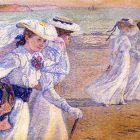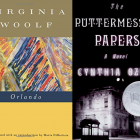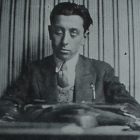Natural History’s Echoes

Andrea Barrett’s new book, Natural History, out tomorrow, is a collection of echoes—names and references that have become familiar across the years to Barrett’s readers, filtering through her collections and novels since the arrival of her 1996 book, Ship Fever. Natural History also features details that bridge from one story in this collection to the next, yoking the whole together. But even more than providing concrete ties between the stories, these details—paint flecks on a lover’s arm, a decades-old scar, a fox fleeing across pages and across time—allow for the slow dance of the final novella to take its ultimate shape: Rose Marburg retelling the story of Henrietta Atkins and her friend Daphne Bannister, reshaped to be, in many ways, the story of Rose and her friend Deirdre, and the story of untold stories.
Telling the untold story is the heart of Natural History, and indeed all of the related collections and novels Barrett has written. In Ship Fever, the opening story, “The Behavior of the Hawkweeds,” creates space for invention around the lives and discoveries of scientists such as Gregor Mendel, comprehensively setting the tone for the collection, and features stories told successfully or unsuccessfully, told in a bid to connect or to be withheld. Natural History revolves around Henrietta Atkins, whose story, the book suggests, is one that needs to be told.
Barrett does this deftly. Rather than positioning Henrietta as the protagonist of all of the stories in the collection, the stories constellate around her, within a frame that yokes Rose Marburg and Henrietta in the opening paragraphs. The framing is subtle, perhaps meant to fade into the background against the wonderfully immersive world Barrett has crafted, to emerge only in the final movement of the collection. The frame itself is the book Wonders of the Shore, which also provides the title to the opening story in Natural History. Wonders of the Shore is not Henrietta’s book, but one written by Henrietta’s friend Daphne and inherited by Rose Marburg. The opening paragraphs describe the book—its unassuming but appealing in shape and color—and Henrietta is introduced as someone deserving of Daphne’s thanks. “One of Henrietta’s relatives, Rose Marburg, inherited the book,” the narrator says, “but for a long time Rose didn’t look at it.”
From there, familiar Rose Marburg disappears from view and Henrietta emerges: the small-town school teacher who did not go on to have the public career and relative fame of her friend. At the end of the story’s second section, the implied impetus for the collection arrives: “Grateful students mention her as they in turn appear in the newspaper for one thing or another. Appreciative colleagues thank her as they retire. The tone is invariably kind—except for the notes about Daphne’s visits, which are colored by something that wouldn’t be there if either of the women had married. Now they seem to point at something. They might not have been read that way then.”
The phrasing, that something, may seem to tease queerness, but in the case of Henrietta and Daphne, what is queer relies on the older sense of the word: something peculiar and not quite approved of. Something surprising, something out of step. The stories in Natural History take differing approaches to this, but each of them is, without doubt, a study in surprise. In “Wonders of the Shore,” it is Henrietta herself who does something shocking: she tells a lie that dramatically alters the course of her own life. She is vacationing with Daphne at Appledore Island, where both social and intellectual life revolve around the parlor of Celia Thaxter. Daphne integrates easily into the coveted inner circle, but Henrietta finds herself at the margins. On one hand, this is emblematic of the connection between the two: Daphne is the one audacious enough to take bold, perhaps careerist, strides, and Henrietta is hemmed in by personal and economic necessity, taking care of her elderly mother and supporting them both by teaching. Henrietta notes:
Daphne wrote to Darwin, and was answered. Daphne wrote to Asa Gray. Daphne wrote about climbing plants and burrowing spiders, publishing more and more articles and then a book, and another and another, earning enough money from those (and also from the part of her writing life she kept quiet) to stop teaching at the academy where she’d been working when they met. Henrietta fell even further behind…Only in the summers could she pursue her own investigations wholeheartedly, keeping the thread alive during the school year by stealing an hour or two at night, after her lessons were prepared.
Their friendship is tested by this tension, brought to one kind of a head at Appledore Island, after Henrietta makes the acquaintance of a painter at Mrs. Thaxter’s.
Though Henrietta has been in a long-term relationship with Mason, a man from her hometown, a relationship on an inevitable trajectory toward marriage and children, she tells the painter, Sebby, that Mason has broken off their relationship in a letter. Henrietta and Sebby are simply gathering their mail at the same time, and while she reads a letter from Mason—“chatty, inconsequential”—and thinks about the future she might have with Mason, “which at least part of her had thought she wanted,” something changes. The moment it happens is couched in questions: “Why, then, did she crumple the pages as Sebby looked up from his own? Why tighten her lips, stare blindly at the ground, let her eyes fill?” And once she has said the untrue thing, the question redoubles: “What was she doing?”
Henrietta, throughout this whole collection, is so often shown as being a source of knowledge that to witness her profound uncertainty makes the surprise feel all the more organic—she surprises herself. But, as with even the most surprising discoveries, there is a logic to it: “the story she’d invented without thinking felt almost true, and Sebby was as responsive as she’d somehow known he would be, his interest in her sharply fanned.” By one way of thinking, it is the scientific method at work: observation leads to a hypothesis to be tested. By another, here is the origin of that disapproval hanging about Daphne’s association with Henrietta, but Henrietta’s unmarried state is not due to a liaison with Daphne nor to her taking her influential friend’s advice to remain single, specifically, but, as Henrietta remembers, “so that, for barely more than a week, she could touch Sebby’s paint-flecked arm and feel his hair against her lips.” This detail is one of those stories never told to anyone else, but an important one, an unexpected force in Henrietta’s life.
The book’s second story, “The Regimental History,” first published as a Ploughshares Solo, takes the reader further back in Henrietta’s history, following her experiences managing the Deverell family’s mail and caring for Bernard, the family’s youngest child. “An excellent speller with a tidy, legible hand and a curiosity that offended some of her neighbors,” Henrietta organizes, annotates, and eventually replies to the letters sent by the two eldest Deverell sons, Vic and Izzy, who have enlisted for the Union and write home with news of the Civil War. This is another story about untold stories, one in which Henrietta plays a more peripheral role, and the construction of the story reinforces that: though the first of the story’s numbered sections focuses on Henrietta’s progression from child to teacher, the second section of the story shifts to the young adult Bernard, now Henrietta’s student and his uncle Izzy’s amanuensis. Bernard is helping Izzy prepare notes for Savery Stokes, a fellow soldier aiming to write a regimental history that will exonerate them from blame for failure in battle. The ongoing tension between the story told by newspapers and officers against the story of the soldiers, mismanaged and abandoned, speaks to the ongoing themes of the collection, but the final act of the story takes another surprising turn: the point of view shifts to Savery Stokes’s younger sister, who has been left with Savery’s task. Sissy Stokes’s story is that of the archivist, the preservationist, and the hope for a story, correctly told.
“The Regimental History” also includes an unmistakable connection between Henrietta and Rose. In “The Mysteries of Ubiquitin,” from Barrett’s 2002 collection, Servants of the Map, Rose Marburg, at nearly nine years old, insists to notable entomologist Peter Kotov: “I am a very good speller.” It is an incredibly small detail, but it attests to their lifelong competence and their positions on the edges of their scientific worlds. Though both have the capacity for greatness, neither commands that intellectual and scholarly space in the same way as certain friends and family members. These details link them even more than their familial connection, and these are the details that make the final turn in Natural History possible, and that make Rose and Henrietta’s story one and the same.
Servants of the Map, “The Forest,” first published in the Winter 1996-97 Issue of Ploughshares, treats readers to a view of a party in Philadelphia—a gathering of scientists and their graduate student protégés. One of them is Rose Marburg, but the story belongs to Rose’s sister Bianca, who is, when we return to Rose in Natural History, gone. In “The Forest,” Bianca accompanies another outsider, an elderly Polish scientist who, by virtue of his age, his physical condition, and his jetlag, is consigned to the fringes of things. A little demonstration he performs for Bianca leads to a garden fountain overflowing with bubbles; that bubbling fountain reappears in Rose’s memory in “Natural History,” as she recounts the party with her friend Deirdre; Daphne Bannister’s book Wonders of the Shore also makes a brief, untitled appearance as an artifact belonging to the sisters’ mother, Suky, in “The Forest.” Everywhere one looks, there are bridges, some as overt as stone, and some seemingly as insubstantial as a leaning blade of grass, but the effect is comprehensive.
The effect also works on Rose, who, by the end of “Natural History,” has turned her attentions away from the competitive world of science—another echo of Bianca, perhaps, in “The Forest”—and into telling stories about women scientists, which is also reminiscent of Henrietta’s pamphlets and proceedings that stay stubbornly local. “Often,” Rose thinks, in “Natural History,” “I don’t know what I mean; when I try to say what I mean, I lie; it seems I only tell the truth when I’m talking about someone else.” And from there, other untold stories arrive: Rose and Deirdre’s story, which is also Henrietta and Daphne’s story, remade with different names.
The two stories merge, a kind of palimpsest in which the past is visible through the present and then shaded, artfully, by another hand. The effect is at once familiar and fresh, like being reminded of something half-forgotten and all the more treasured in the recollection, which has been the enduring feeling of all of these stories Andrea Barrett has written, across all these years.
About Author
Holly M. Wendt is Associate Professor of English and Director of Creative Writing at Lebanon Valley College. Holly is a recipient of fellowships from the American Antiquarian Society, Jentel Foundation, and the Hambidge Center. Their writing has appeared in Four Way Review, Shenandoah, Barrelhouse, Memorious, The Rumpus, and elsewhere. Learn more at hollymwendt.com or find Holly on Twitter @hmwendt.



